The AMD Radeon R9 380X Review, Feat. ASUS STRIX
by Ryan Smith on November 23, 2015 8:30 AM EST- Posted in
- GPUs
- AMD
- Radeon
- Asus
- Radeon 300
Overclocking
Finally, no review of a video card would be complete without a look at overclocking performance.
With ASUS setting the STRIX R9 380X’s factory clockspeed to 1030MHz – 60MHz ahead of AMD’s reference clock of 970MHz – ASUS is already significantly eating into the headroom available on the card, and the 1050MHz OC mode further cuts into that. We don’t have any voltage control (we can’t even read the voltage) so the card can only be overclocked as far as the Tonga GPU can go on default voltage. Meanwhile ASUS hasn’t touched the memory clockspeed at all, which should mean there’s a bit more headroom there to play with.
| ASIS STRIX R9 380X Overclocking | ||||
| ASUS STRIX R9 380X OC (Stock) | ASUS STRIX R9 380X (OC) | |||
| Boost Clock | 1030MHz | 1100MHz | ||
| Memory Clock | 5.7Gbps | 6.4Gbps | ||
| Power Limit | 100% | 115% | ||
Ultimately we were able to push the STRIX R9 380X OC from 1030MHz to 1100MHz on the GPU, a 70MHz (7%) overclock. I fully expect that Tonga could do better with more voltage – and the ASUS cooler could keep up – but at the same time it would take a bad power efficiency situation and make it worse. Otherwise memory overclocking was a bit more fruitful, as we were able to push the card from 5.7Gbps to 6.4Gbps, a 700Mbps (12%) performance increase. Note that relative to the original 7970, the R9 380X has a narrower 256-bit memory bus, so if there are any situations where GCN 1.2’s color compression technology can’t make up the difference, a memory overclock may help to close the gap.
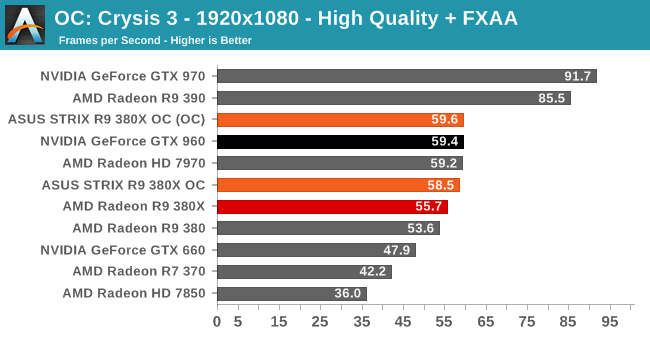
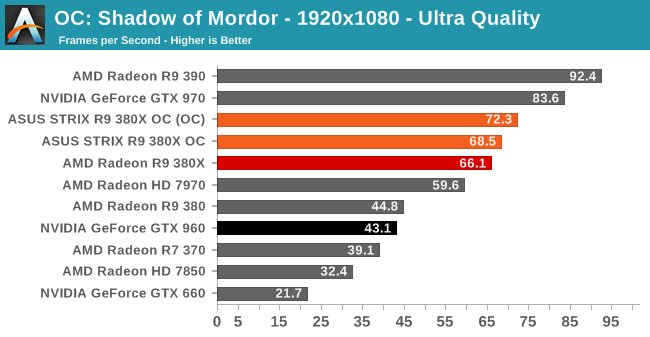
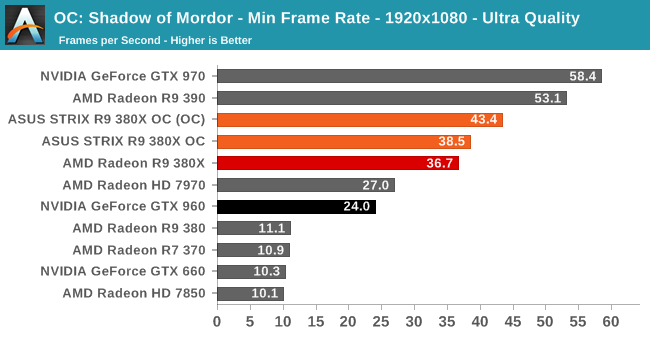
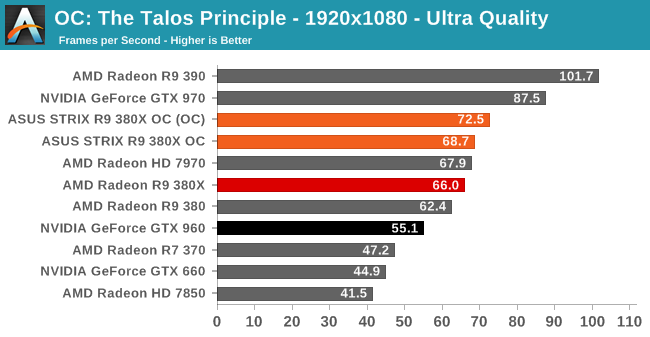
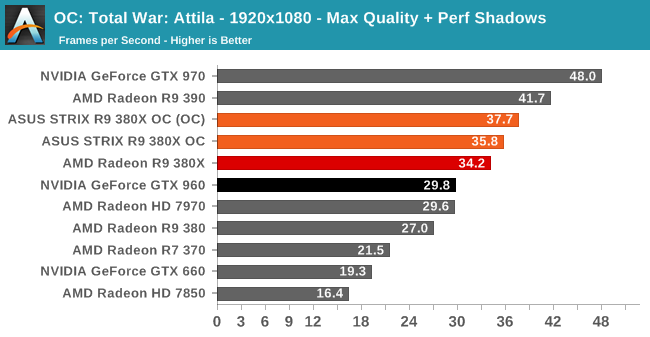
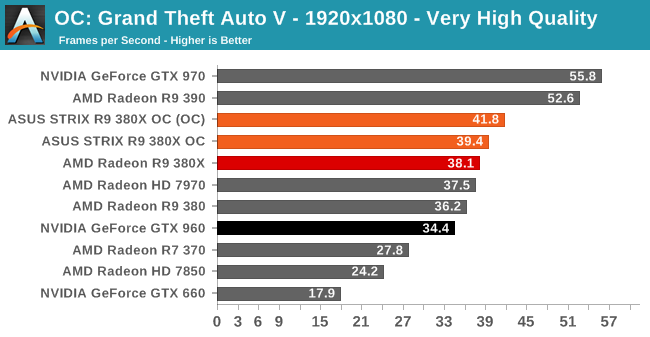
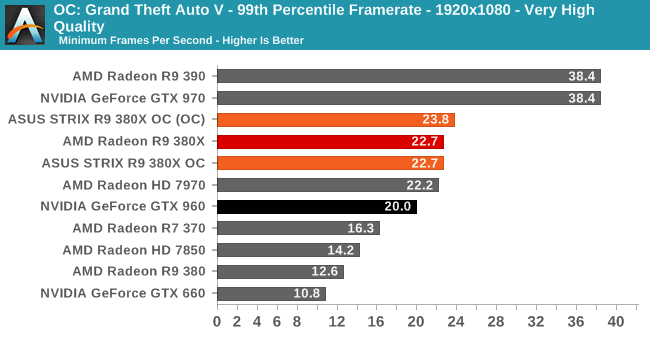
Overall overclocking is good for another 5% performance increase over the STRIX R9 380X's factory overclock. Though enough to be significant, as we guessed base upon the clockspeeds, ASUS has already tapped much of the overclocking headroom available on the card. For reference clocked cards on the other hand, assuming that they can overclock similarly well, this means they can look forward to a total of 10% or so from overclocking.
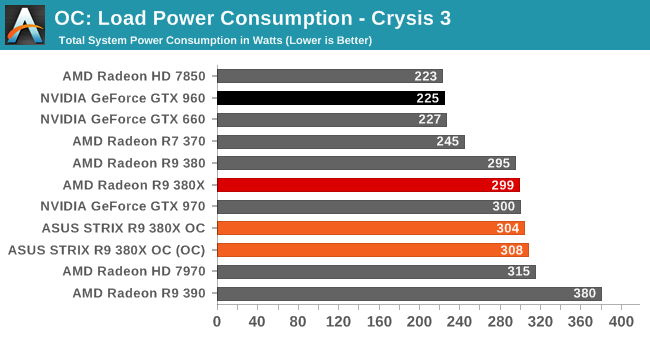
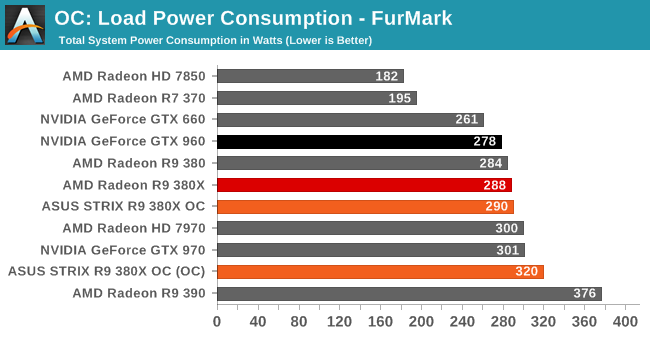
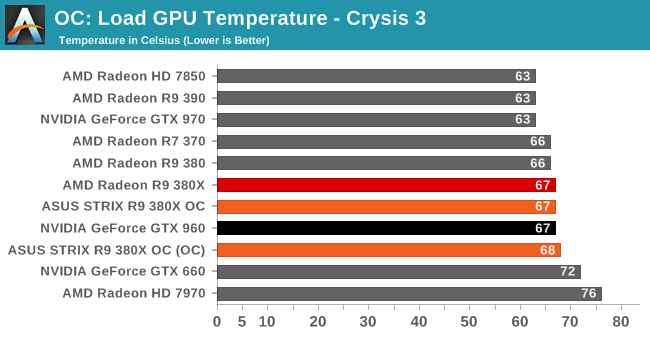
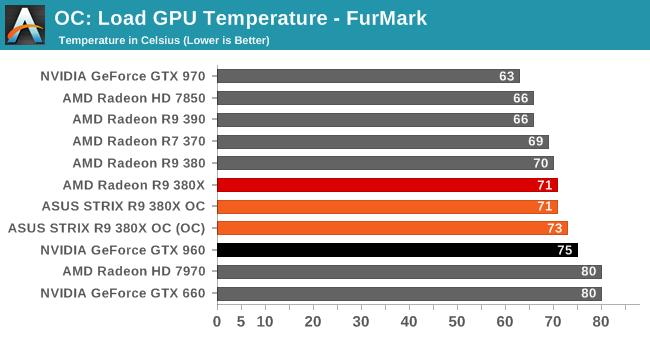
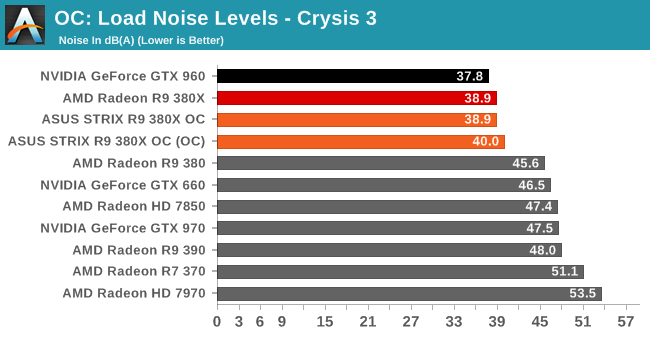
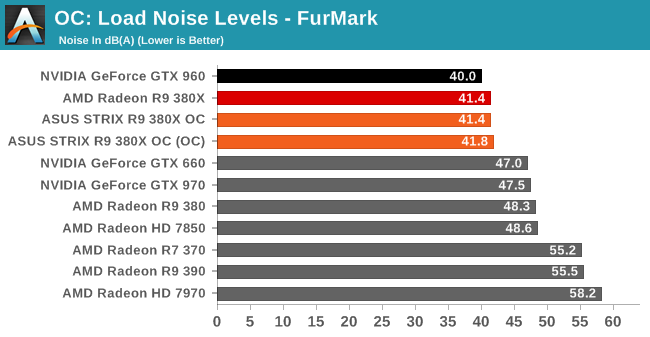
Since we can't overvolt, the power/temp/noise impact of overclocking is limited. Under gaming workloads the difference is a handful of watts and a nothing for temperature or noise. Otherwise FurMark, with the higher power target, pushes the STRIX card a bit harder, but everything still remains within reason.










101 Comments
View All Comments
FriendlyUser - Monday, November 23, 2015 - link
This is not a bad product. It does have all the nice Tonga features (especially FreeSync) and good tesselation performance, whatever this is worth. But the price is a little bit higher than what would make a great deal. At $190, for example, this card woule be the best card in middle territory, in my opinion. We'll have to see how it plays, but I suspect this card will probably find its place in a few months and after a price drop.Samus - Monday, November 23, 2015 - link
Yeah, it's like every AMD GPU...overpriced for what it is. They need to drop the prices across the entire line about 15% just to become competitive. The OC versions of the 380X is selling for dollars less than some GTX970's, which use less power, are more efficient, are around 30% faster, and you could argue have better drivers and compatibility.SunnyNW - Monday, November 23, 2015 - link
To my understanding, the most significant reason for the decreased power consumption of Maxwell 2 cards ( the 950-60-70 etc.) was due to the lack of certain hardware in the chips themselves specifically pertaining to double precision. Nvidia seems to recommend Titan X for single precision but Titan Z for DP workloads. I bring this up because so many criticize AMD for being "inefficient" in terms of power consumption but if AMD did the same thing would they not see similar results? Or am I simply wrong in my assumption? I do believe AMD may not be able to do this currently due to the way their hardware and architecture is configured for GCN but I may be wrong about that as well, since I believe their 32 bit and 64 bit "blocks" are "coupled" together. Obviously I am not a chip designer or any sort of expert in this area so please forgive my lack of total knowledge and therefore the reason for me asking in hopes of someone with greater knowledge on the subject educating myself and the many others interested.CrazyElf - Monday, November 23, 2015 - link
It's more complex than that (AMD has used high density libraries and has very aggressively clocked its GPUs), but yes reducing DP performance could improve performance per watt. I will note however that was done on the Fury X; it's just that it was bottlenecked elsewhere.Samus - Tuesday, November 24, 2015 - link
At the end of the day, is AMD making GPU's for gaming or GPU's for floating point\double precision professional applications?The answer is both. The problem is, they have multiple mainstream architectures with multiple GPU designs\capabilities in each. Fury is the only card that is truly built for gaming, but I don't see any sub-$400 Fury cards, so it's mostly irrelevant since the vast majority (90%) of GPU sales are in the $100-$300 range. Every pre-Fury GPU incarnation focused too much on professional applications than they should have.
NVidia has one mainstream architecture with three distinctly different GPU dies. The most enabled design focuses on FP64\Double Precision, while the others eliminate the FP64 die-space for more practical, mainstream applications.
BurntMyBacon - Tuesday, November 24, 2015 - link
@Samus:: "At the end of the day, is AMD making GPU's for gaming or GPU's for floating point\double precision professional applications?"Both
@Samus: "The answer is both."
$#1+
@Samus: " Fury is the only card that is truly built for gaming, but I don't see any sub-$400 Fury cards, so it's mostly irrelevant since the vast majority (90%) of GPU sales are in the $100-$300 range. Every pre-Fury GPU incarnation focused too much on professional applications than they should have."
They tried the gaming only route with the 6xxx series. They went back to compute oriented in the 7xxx series. Which of these had more success for them?
@Samus: "NVidia has one mainstream architecture with three distinctly different GPU dies. The most enabled design focuses on FP64\Double Precision, while the others eliminate the FP64 die-space for more practical, mainstream applications."
This would make a lot of sense save for one major issue. AMD wants the compute capability in their graphics cards to support HSA. They need most of the market to be HSA compatible to incentivize developers to make applications that use it.
CiccioB - Tuesday, November 24, 2015 - link
HSA and DP64 capacity have nothing in common.People constantly confuse GPGPU capability with DP64 support.
nvidia GPU have been perfectly GPGPU capable and in fact they are even better than AMD ones for consumer calculations (FP32).
I would like you to name a single GPGPU application that you can use at home that makes use of 64bit math.
Rexolaboy - Sunday, January 3, 2016 - link
You asked a question that's been answered in the post you reply to. Amd wants to influence the market to support fp64 compute because it's ultimately more capable. No consumer programs using fp64 compute is exactly why amd is trying so hard to release cards capable of it, to influence the market.FriendlyUser - Tuesday, November 24, 2015 - link
It's not just DP, it's also a lot of bits that go towards enabling HSA. Stuff for memory mapping, async compute etc. AMD is not just building a gaming GPU, they want something that plays well in compute contexts. Nvidia is only being competitive thanks to the CUDA dominance they have built and their aggressive driver tuning for pro applications.BurntMyBacon - Tuesday, November 24, 2015 - link
@FriendlyUser: "It's not just DP, it's also a lot of bits that go towards enabling HSA. Stuff for memory mapping, async compute etc. AMD is not just building a gaming GPU, they want something that plays well in compute contexts."This. AMD has a vision where GPU's are far more important to compute workloads than they are now. Their end goal is still fusion. They want the graphics functions to be integrated into the CPU so completely that you can't draw a circle around it and you access it with CPU commands. When this happens, they believe that they'll be able to leverage the superior graphics on their APUs to close the performance gap with Intel's CPU compute capabilities. If Intel releases better GPU compute, they can still lean on discrete cards.
Their problem is that there isn't a lot of buy-in to HSA. In general, there isn't a lot of buy-in to GPU compute on the desktop. Sure there are a few standouts and more than a few professional applications, but nothing making the average non-gaming user start wishing for a discrete graphics card. Still, they have to include the HSA (including DP compute) capabilities in their graphics cards if they ever expect it to take off.
HSA in and of itself is a great concept and eventually I expect it will gain favor and come to market (perhaps by another name). However, it may be ARM chip manufacturers and phones/tablets that gain the most benefit from it. There are already some ARM manufacturers who have announce plans to build chips that are HSA compatible. If HSA does get market penetration in phones/tablets first as it looks like may happen, I have to wonder where all the innovative PC programmers went that they couldn't think of a good use for it with several years head start.